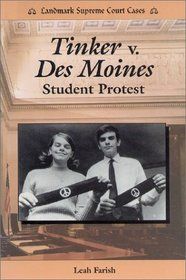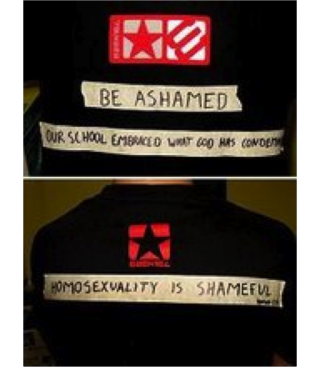Bias
Free Speech vs. Hate Speech
What’s the difference and what can schools do?
Posted December 5, 2016
There have been a lot of strong viewpoints swirling around during this election cycle and some bloggers, tweeters, and others contributing to the public conversation support their ideas with evidence and some don’t. This blog post is an effort to provide some measured and research-based guidance for educators struggling to create safe and affirming learning environments in the current social context where acts of hate speech and verbal harassment seem to be on the rise. I aim to present a framework based in legal precedent and existing school policies and procedures to support the hard work that classroom teachers and school administrators are engaging in since the election.
Free speech: What does the First Amendment say for schools?

There are three major Supreme Court decisions that shape how K-12 public schools need to approach First Amendment issues: Tinker v. Des Moines School District (1969), Bethel School District No. 403 v. Fraser (1986), and Hazelwood School District v. Kuhlmeier (1988). Tinker protected student free speech rights by outlining two key prongs of when schools could limit student speech. If the speech causes either a (1) material and substantial disruption or (2) collides with the rights of others, K-12 public school leaders can legally restrict such speech.
The Fraser case followed and allowed schools to limit student speech that was lewd, vulgar, or counter to the educational mission of the school. In Hazelwood, the Court established that school officials could exert editorial control in school-sponsored expressive activities, such as the student newspaper. In a 5-4 decision, the Court held that “…educators do not offend the First Amendment by exercising editorial control over the style and content of student speech in school-sponsored expressive activities….” In short, school personnel control school-sponsored expression that could reasonably be seen as bearing the stamp of approval of the school. These three cases provide the foundation for legal interpretations of First Amendment cases in schools.
There have been several “T-shirt cases,” that I wrote about in an earlier post, that have made their way through the courts that provide helpful case studies of when acts of student expression “collide with the rights of others”.

For example, in Harper v. Poway, 2006 a student wore a t-shirt that stated: “Be Ashamed. Our school embraced what god has condemned. Homosexuality is Shameful.” The principal gave the student a few choices to conceal the message, but the student refused them and spent the day in the office. The 9th circuit court wrote, “that vulgar, lewd, obscene, indecent, and plainly offensive speech by definition, may well 'impinge upon the rights of other students,' even if the speaker does not directly accost individual students with his remarks. Chandler, 978 F.2d at 529 (quoting Tinker, 393 U.S. at 509). So too may other speech capable of causing psychological injury. The Tenth Circuit has held that the 'display of the Confederate flag might …interfere with the rights of other students to be secure and let alone,' even though there was no indication that any student was physically accosted with the flag, aside from its general display. West v. Derby Unified Sch. Dist., 206 F.3d 1358, 1366 (10th Cir. 2000).” The court concluded, “Harper's wearing of his T-shirt ‘collides with the rights of other students’ in the most fundamental way” (p. 1178) and supported the principal’s intervention in this case.
In an update from when I wrote that post, Zamecnik v. Indian Prairie School District, (2011) a student wore a shirt that stated, “Be Happy, Not Gay” during the school’s Day of Silence event which was designed to promote awareness of violence against LGBT people. The school asked the student to tape over the message, but on appeal the higher court found that the “substantial disruption” had not been sufficiently established and the school was wrong in limiting student speech in this case. There have been other cases where schools restricted advocacy acts by students to support their LGBT peers and tried to use the First Amendment to argue their case.
Speech affirming the rights of others & viewpoint discrimination:
In Gillman v. Sch. Bd. for Holmes County, (2008) The U.S. District Court for the Northern District of Florida ruled that the high school principal’s decision to prohibit students from displaying messages or wearing symbols advocating acceptance of gay people violated the students’ First Amendment right to free speech. The court concluded that the school district could not justify banning the speech based on the substantial disruption standard established in Tinker and that the decision constituted impermissible viewpoint discrimination based on the principal’s religious views on homosexuality.
In Morrison v. Board of Education of Boyd County, (2006), the Boyd County School District agreed to develop written policies and mandatory student training as part of their Consent Decree with the ACLU and Boyd County Gay-Straight Alliance. The training, consisting of a one-hour video, an explanation of the policy, and comments from the instructor as well as an opportunity for students to respond with written comments, was mandatory. At least one set of parents contended that the written policy violated their First Amendment rights and the training violates their religious beliefs that homosexuality is harmful and a destructive lifestyle. The court found that mandatory student training to reduce homophobic harassment is speech by the school and need not be viewpoint neutral as long as the viewpoint is consistent with the educational mission of the school. So if schools shouldn't restrict student speech that is affirming of student identities, and can limit speech that is harmful, where does hate speech come into the equation?
Hate Speech: What counts?
Since K-12 schools have a different legal context, hate speech isn't as relevant for that context. However, college campuses have much more latitude in First Amendment cases, so hate speech may be used as the floor: what is the absolute lowest form of expression that campuses can legally restrict? The legal definition for hate speech in general is quite limited and based on a 1942 Supreme Court decision (Chaplinsky) that defined it as, “insulting or 'fighting' words – those which by their very utterances inflict injury or tend to incite an immediate breach of the peace.” This was later clarified in a 1969 Supreme Court decision that protected a KKK member’s racist speech and created the “imminent danger” test. This response to hate speech was reinforced in the 2011 Snyder v. Phelps decision that upheld the right of the Westboro Baptist Church to publicly protest (in this case at an Iraq veteran’s funeral) with anti-gay signs with phrases such as “God hates fags.” The Court found that speech in a public setting, about a public issue, couldn’t be liable for emotional distress, even if the speech is found to be "outrageous". The Supreme Court continues to uphold a very broad protection of the First Amendment rights of adults in public venues, as long as the speech is not promoting violence.
Fortunately, educational institutions do have a different set of policies and protocols at their disposal to limit and respond to acts of hate speech that might not rise to the legal definition established by the Supreme Court. Most educational institutions have provisions against discrimination and harassment that include physical, verbal, and psychological behaviors and a list of “protected classes”. If speech acts are targeted at an individual or group and violate your school or campus policy, you should be able to stop it (if safe to do so), report it, and seek some sort of remedy and support.
What can schools do?
Why are First Amendment issues different in K-12 public schools? Educational law experts have argued that there are special characteristics of schools including: 1) age of students, 2) attendance requirements, 3) multiple school constituencies, 4) heightened safety considerations, 5) need for public accountability, 6) school-associated nature of much student speech, 7) and the need to promote educational goals (Warnick, 2009). Due to these various factors, the rules in K-12 public schools are different than those in private schools and even higher education. Although public universities share most of these “special characteristics” (#3-7), since they are dealing mostly with legal adults and non-compulsory educational settings, the principles do vary, however, I would encourage any educator to keep these principles in mind in deciding when and how to limit student speech. Some guiding questions to consider include:
- Did the speech act cause a “substantial disruption” to the learning environment?
- Does it harm, or ‘substantially collide with the rights of others” (threats of violence, or psychological violence)?
- Does it violate other school policies (bullying, harassment, nondiscrimination)?
- Does it contradict the educational mission and values of the school?
If you can answer yes to any of these questions, then I would argue that you have the right to limit that speech act so as to reduce its negative impact on others and to implement any policy or response protocols that should be in place to address incidents of harassment and discrimination. How do you do that?
- In T-shirt cases, schools have given students the option of turning the shirt inside-out, putting another shirt on over it, or taping over the offending message.
- In classroom discussions, I would name what a student has just said and take immediate action – either by publicly addressing the class or privately engaging with the student, “that comment is disparaging the identities of students in our school and constitutes harassment, as a result I need to ask you to step outside so we can discuss what should happen next.”
- If students are posting signs or other symbols that have histories of violence (confederate flag, swastikas, etc.), I would recommend removing them, ask them to stop posting, and inform them that those images contradict the educational mission of the school as it puts other students in harm’s way as targets for verbal and psychological harassment.
- In cases of cyberbullying or online speech schools should take action if it is having an impact on the school environment or the student’s access to educational opportunities. I wrote an earlier post about cyberbullying.
One of the more challenging decisions is deciding whether or not to suppress student speech since the hope of many educators is to teach students how to engage respectfully in thoughtful debate and critical thinking. However, when there are speech acts that denigrate groups of people, and promote hate or violence, action must be taken. Overall, I believe the ethical duty to keep students safe and protect the integrity of the learning environment should override any concerns about free speech and I hope this resource can provide educators with the confidence and resources they need to be proactive about creating and maintaining safe and productive learning environments.
References
Stader, D., Meyer, E.J. & Graca, T. (2009) Sexual Minority Youth and the First Amendment. Paper presented at the annual meeting of the American Educational Research Association. San Diego, CA.
Warnick, B. R. (2009). Student Speech Rights and the Special Characteristics of the School Environment. Educational Researcher, 38(3), 200-215.
Legal Cases:
Bethel School District No. 403 v. Fraser 478 U. S. 675 (1986).
Brandenburg v. Ohio, 395 U.S. 444, at 447 (1969)
Chaplinsky v. New Hampshire, 315 U.S. 568, 572 (1942
Gillman v. Sch. Bd. for Holmes County, Fla., No. 08-34 (N.D. Fla. July 24, 2008)
Harper v. Poway Unified School District (445 F.3d 1166 (9th Cir.) 2006).
Hazelwood School District v. Kuhlmeier, 484 U. S. 260 (1988).
Morrison v. Board of Education of Boyd County, 419 F.Supp.2d 937 (E. D. KY, 2006).
Nixon v. Northern Local School District Board of Education, 383 F. Supp.2d 965 (S.D. Ohio, E. D., 2005).
Snyder v. Phelps 562 U.S. 443 (2011)
Tinker v. Des Moines School District 393 U. S. 503 (1969).
Zamecnik v. Indian Prairie School District #204, et. al., No. 10-2485, 10-3635 (7th Circuit 2011).




